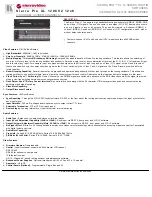
Accessing the switch 17
2.
Apply, verify, and save the configuration.
RADIUS authentication features
The switch supports the following RADIUS authentication features:
•
Supports RADIUS client on the switch, based on the protocol definitions in RFC 2138 and RFC 2866.
•
Allows RADIUS secret password up to 32 bytes.
•
Supports secondary authentication server so that when the primary authentication server is unreachable, the
switch can send client authentication requests to the secondary authentication server. Use the
/cfg/sys/radius/cur
command to show the currently active RADIUS authentication server.
•
Supports user-configurable RADIUS server retry and time-out values:
•
Time-out value = 1-10 seconds
•
Retries = 1-3
•
The switch will time out if it does not receive a response from the RADIUS server in one to three retries. The
switch will also automatically retry connecting to the RADIUS server before it declares the server down.
•
Supports user-configurable RADIUS application port. The default is 1645/User Datagram Protocol (UDP)-
based on RFC 2138. Port 1812 is also supported.
•
Allows network administrator to define privileges for one or more specific users to access the switch at the
RADIUS user database.
•
Allows the administrator to configure RADIUS backdoor and secure backdoor for Telnet, SSH, HTTP, and
HTTPS access.
User accounts for RADIUS users
The user accounts listed in the following table can be defined in the RADIUS server dictionary file.
Table 2 User access levels
User account
Description and tasks performed
User
User interaction with the switch is completely passive; nothing can be changed on the switch.
Users may display information that has no security or privacy implications, such as switch
statistics and current operational state information.
Operator
Operators can only effect temporary changes on the switch. These changes are lost when
the switch is rebooted/reset. Operators have access to the switch management features
used for daily switch operations. Because any changes an operator makes are undone by a
reset of the switch, operators cannot severely impact switch operation, but do have access to
the Maintenance menu. By default, the operator account is disabled and has no password.
Administrator
Administrators are the only ones that can make permanent changes to the switch
configuration — changes that are persistent across a reboot/reset of the switch.
Administrators can access switch functions to configure and troubleshoot problems on the
switch level. Because administrators can also make temporary (operator-level) changes as
well, they must be aware of the interactions between temporary and permanent changes.
1. Apply
3. Save
2. Verify
















































